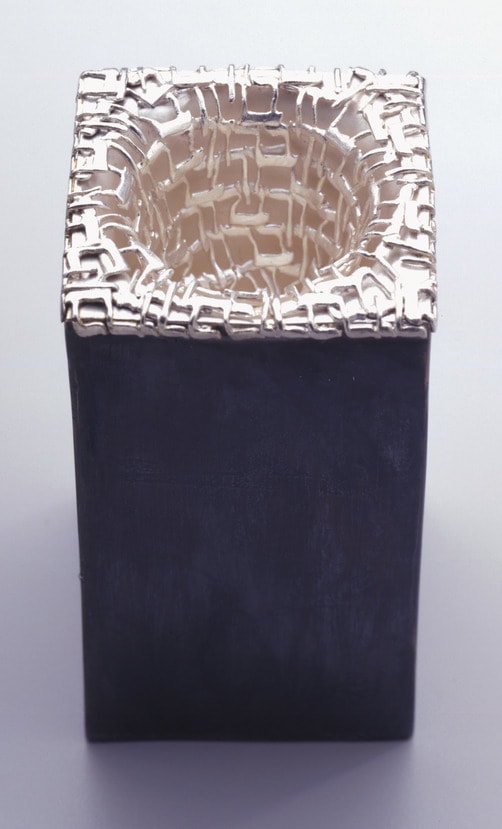
- Object Name:
- Kiddush Cup
- Artist/Maker:
- Alyssa Dee Krauss
- Bio:
- American, b. 1962
- Title:
- Blessed
- Place Made:
- Massachusetts, United States
- Date:
- 2000
- Medium:
- Silver: hand-worked, spun, cast, and oxidized
- Dimensions:
- 4 3/8 × 2 5/16 × 2 5/16 in. (11 × 5.8 × 5.8 cm)
- Credit Line:
- Purchase: Contemporary Judaica Acquisitions Committee Fund
- Accession Number:
- 2001-81
Not On View
"Baruch" / "Blessed"
As the first prayer, welcoming the Sabbath, and most of our holy ritual services, the Kiddush in many ways serves to separate the sacred from the profane. Marking the moment when the week becomes the Sabbath, when the day becomes the holy day and even in another variation, when we interrupt our lives to acknowledge death. "Blessed" represents this transition from the mundane to the sacred.
The common box or carton-like exterior, with its squared opening references architecture and the man-made world. Its visibly "used" and tarnished surface reveals exposure to everyday life. The rounded interior, however, is meant to represent the cycle of life, while its reflective white surface, made from pure silver, creates a more sacred interior space.
There is a third layer also made of pure silver. It sits like a sieve on top of the cup's opening. This layer is entirely constructed/wrought out of the word "baruch" repeated over and again. In Hebrew "baruch" means "blessed".
The sacremental wine bathes in these words and passes through them twice, when the cup is filled and again when it is emptied. In doing so, the wine is blessed. Also, the lips must embrace the words in order to drink from the cup and complete the Kiddush ritual. By this act, the drinker too, becomes blessed.
Both interior and exterior are made from different forms of the same material, reminding us that secular concerns are a part of the sacred, and that the divine can always be found in our everyday world.
-Alyssa Dee Krauss
As the first prayer, welcoming the Sabbath, and most of our holy ritual services, the Kiddush in many ways serves to separate the sacred from the profane. Marking the moment when the week becomes the Sabbath, when the day becomes the holy day and even in another variation, when we interrupt our lives to acknowledge death. "Blessed" represents this transition from the mundane to the sacred.
The common box or carton-like exterior, with its squared opening references architecture and the man-made world. Its visibly "used" and tarnished surface reveals exposure to everyday life. The rounded interior, however, is meant to represent the cycle of life, while its reflective white surface, made from pure silver, creates a more sacred interior space.
There is a third layer also made of pure silver. It sits like a sieve on top of the cup's opening. This layer is entirely constructed/wrought out of the word "baruch" repeated over and again. In Hebrew "baruch" means "blessed".
The sacremental wine bathes in these words and passes through them twice, when the cup is filled and again when it is emptied. In doing so, the wine is blessed. Also, the lips must embrace the words in order to drink from the cup and complete the Kiddush ritual. By this act, the drinker too, becomes blessed.
Both interior and exterior are made from different forms of the same material, reminding us that secular concerns are a part of the sacred, and that the divine can always be found in our everyday world.
-Alyssa Dee Krauss
Information may change as a result of ongoing research.